We didn’t plan to do a hive inspection again so soon, but it turns out it was good we checked our swarm hive, now named the Salvia hive, this weekend.

In a few weeks we'll have multiple hives in our apiary, so each is being named for record keeping purposes (click any image to enlarge)
Since the bees arrived all signs have been suggesting that the hive is functionally normal even though we hadn’t yet sighted the Queen, eggs, or brood. The bees have been very active, especially on warmer afternoons, foraging for nectar and pollen.
One change noted this week was that in the 24 hours prior to this inspection, feed consumption had suddenly decreased by 50%. The question was, why?
The last time we briefly peeked inside the hive, the bees had only been in residence for 72 hours. When we checked this weekend, they had been in their new home for 9 days.
As we removed the lid we could see even more bees in the upper hive body than during our first inspection. However, as it’s far too early for any new bees to have hatched, this simply suggested the bees were moving up in the hive.
However, even though we’d only been beekeepers for less than two weeks, we could tell as soon as the cover was removed that something wasn’t quite right. There clearly was too much new comb visible between a couple of the frames.
We carefully teased the frames apart, and like last week we noticed a number of bees festooning between frames.
As we moved the frames a section of the protruding comb between the frames began to tear away. We noticed that rather than the comb being drawn directly from the foundation the bees had constructed this fragile comb directly from the frame’s top bar.
Comb that is built out of place is often referred to by beekeepers as Burr Comb.
The bees are doing what bees do. If they have extra space in which to build extra layers of comb, they will. The fault is entirely ours. While the bees are drawing out the frames with comb, at the end of the last inspection we should have pushed all of the frames tightly together into the center of the hive body, so they were touching each other. This minimizes the space between frames, and decreases the likelihood of burr comb formation.
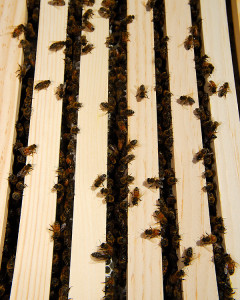
The spacing between the frames was too large in the center, and the bees were building extra comb to fill the gaps
Our frame spacing had resulted in a violation of what is known as ‘bee space’. Bee space is the space within a hive that is large enough for the free passage of bees, but not so large as to encourage the building of excess comb. Any gap between the frames that’s too wide will be filled with comb.
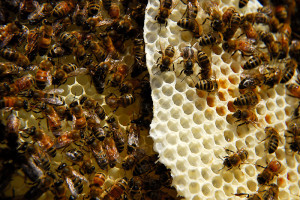
The bees drew most of this frame correctly (left), but some of the comb on this frame was drawn down from the top bar (right)
When building burr comb, the bees will use it, just like any other comb, to store nectar and honey, pollen, or brood. Left undisturbed, this would be fine. The trouble is, this fragile new comb is often not well anchored, and if the comb bridges two frames together (sometimes called bridge or brace comb) it can make future hive inspections challenging, and potentially very damaging.
The ideal is not to have burr comb in the hive, but when it does occur, it’s best to catch it early. We knew we’d need to remove it immediately, and as much as we feel bad to waste any of the efforts of the bees as they build up their new hive, we’d do far more harm if this comb was left in place. Waiting too long to remove burr comb can result in a significant loss of young brood if the Queen is actively laying in those cells.
As removing burr comb takes a little time, and can be messy, we briefly set that box aside, covered it, and proceeded with the rest of our inspection first.
We moved down to the lower hive body, which had no burr comb, and went straight for the two old frames that already had drawn comb in them when the bees first arrived. We knew that during this inspection we should, by now, be able to easily see evidence of brood in the frames, presuming of course that we had a laying Queen present.
When the Queen lays an egg in a cell, the egg is in that stage for a mere 3 days. The next stage is larva, and worker brood are in the larval stage for 6 days. At 9 days the cells in which the larva are housed are capped. The bees then pupate in these cells, and remain there, until they hatch.
The bees had been in this hive for 9 days, and we expected that we may see larva during this inspection.
Sure enough, as the bees moved around the frame we had our first sighting of bee larva! Small white horse-shoe shaped grubs visible within the cells…
This tells us that our Queen is successfully laying eggs within the hive, and that new bees should be hatching soon.
Not only were there larva on these two frames, but there was also capped brood, and brood in the process of being capped. These frames also contained pollen, and the first signs of a little capped honey.
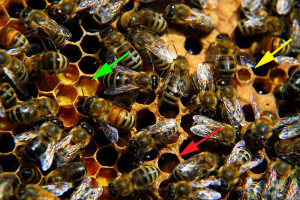
This frame contained nectar, pollen (green arrow), uncapped brood (red arrow), and partially capped brood (yellow arrow)
Worker brood aren’t capped until the 9th day of development, so the presence of capped brood suggests that as soon as the bees had been introduced to their new hive, the workers had cleaned out the two old frames of comb, and the Queen started laying eggs the very first day she arrived!
Having a couple of frames of drawn comb in the hive when we first installed the swarm enabled the Queen to resume egg-laying almost immediately. If there was no drawn comb, the workers would have to draw it out on their arrival, delaying their ability to build up stores of nectar and pollen, and delaying the Queen’s egg laying. Worker bees in late spring and summer live on average for a mere six weeks, so the sooner new bees are reared as replacements, the better it is for the colony at large.
After sighting larva, we quickly replaced the upper hive body and began to remove the errant comb. Overall there wasn’t very much, and fortunately no brood or eggs were present in any of it. A few cells contained a little nectar, which we gave back to the bees, and there was also one section that was packed with beautiful pollen.
It seemed a shame to take all of this fresh pollen away. For now, we have set this comb section flat on the inner cover, with an empty medium over it so the bees can have a chance to rob the pollen back from the comb, and as of the last feeding, they seem to be doing just that.
Simply removing the burr comb though isn’t enough. As beekeepers it’s our responsibility to correct the conditions in the hive that spawned its construction in the first place, or the bees will simply build it again.
We now will be much more careful about placing new frames, especially those which do not yet have fully drawn out comb, as close together as the frames will permit, to help keep our bee space in check and prevent the contruction of additional burr comb. We made a new beekeeper mistake, but the bees have taught us an important lesson, and that’s much of what beekeeping is about. Experience, learning, and adaptation.
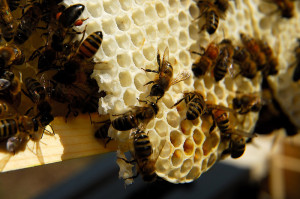
By correcting the frame spacing, we hope to see much less burr comb formation by the next inspection
The only other change we made to the hive was to bring a couple of frames of empty drawn comb down from the upper hive body, to the lower one. The bees have efficiently been building out the upper box, but in the last week have not added much comb to the lower hive body. By moving the comb down, we provide the Queen with more room to lay eggs. Frames of untouched foundation were moved up from the lower hive body for the bees draw out.
We will now leave the bees alone, at least for the next 10 days, unless there’s cause for concern. This time, the sudden decrease we noted in food intake seems likely due to the fact that most of the frames in the upper hive body were drawn out with comb. Feed consumption has increased again now that we’ve switched some empty frames to the upper hive body. The next inspection it will be important to ensure the bees have sufficient room to grow. If not, a third hive body will be added during that inspection to keep the bees happy.
So far the bees are building up well, and the way things are going, we hopefully will have our first generation of baby bees hatching in the Curbstone Valley apiary within the next 10 days!


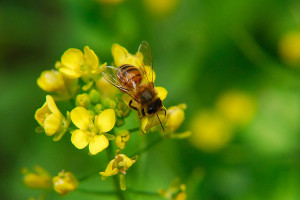
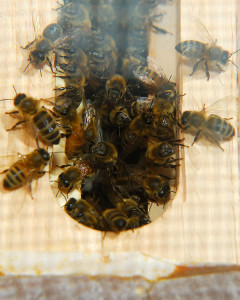



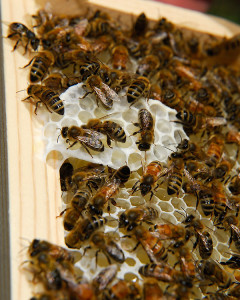

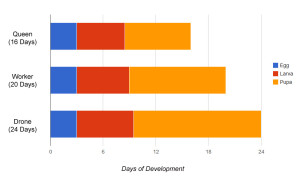
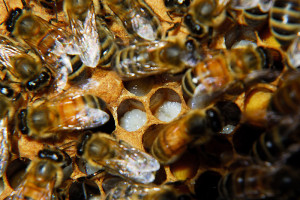
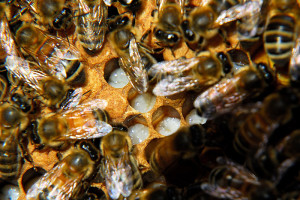

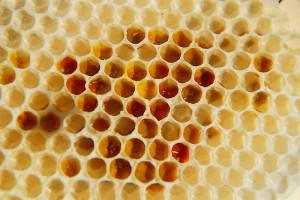








Good one! Looking forward to the next chapter!
Me too…I’m hoping by then that the burr comb will be history! 🙂
Fascinating as always.
So how is spacing between the frames controlled? Are there grooves in the sides of the boxes that the frames rest on or slide in along? or do the frames pretty much sit on top of each other?
For each hive body, there are 8 frames. On the inside of the hive body box there is a rabbet around the edge that serves as a ledge. The top bar of each frame has a short tongue at each end that rests on that groove. There’s a little more room in the box than is needed for 8 frames side by side, in fact, you could almost get 9 frames in each. Aligning the frames across the box is mostly down to the beekeeper’s eye, and manual dexterity! 😉 Once the combs are drawn out, they often are drawn with comb that’s a little wider than the width of the top bar, so that extra play gets used up, but before the combs are drawn it means you can have too much space if you don’t push the frame top bars together next to each other. There are commercial frame spacers available to help get the width more even, but I think the majority of beekeepers don’t use them. Pushing the frames together is usually sufficient, and even though that leaves extra space on the outside edge of the box, the bees don’t tend to work those outside frames much if at all, so it’s not usually an issue. Leave a gap in the middle of the box though, and you end up with what we had to deal with this weekend!
The bees have certainly been busy! And great photography too. It’s almost like you’re right there.
They have been busy! I wasn’t sure how the photographs would turn out. The sun was very bright, and looking through the beekeeping veil and the view finder, was like shooting blind! 😉
We just keep on learning don’t we? I guess my DH not wanting me to have bees is likely a good thing.. only so many hours in the day, but you seem to get it all done. You are amazing.
I talked with the young man who came to our rescue when the oak fell and we found a colony of bees. He lost his 3 hives this winter, but our guys are doing well.
It’s unfortunate he lost his hives, but sadly that’s all too common these days. Even with as strong as these bees are now, getting through winter may be a struggle, and they may not survive. I’m glad though that the feral bees he rescued from the tree are doing well. Hopefully they’re just better able to contend with Varroa mites, and built from a stronger gene pool. I hope they keep going strong!
Fascinating developments!
Clare, do you notice more bees in the garden near you?
Before we hived this swarm, we had a few honeybees around, but mostly bumble bees. Some of that though is probably our nice-one-minute, cold-the-next weather lately. Now though, the bees seem to be everywhere. Even the young rosemary plants we set out this winter are covered in bees. It’s looking like our Goldfields (Lasthenia glabrata) will be blooming soon too, which should really draw the bees into the gardens!
That’s great that the queen is already laying eggs and you’ve got baby bees. I’ve never seen bee larvae before. I love learning about how the bees and their hives work.
Clare,
Looks like you have a good handle on this swarm. Really impressed you got it together so quickly.
This is so interesting. We ended up with a swarm of bees in a house that we were selling. They had found their way under the siding of the house on the second story. We called a bee keeper to come remove them. In order to do so, he had to peel back the carpet in a bedroom and cut a hole in the floor to reach them. It would have been easier to have had them exterminated, but I felt very good having they removed. My dad kept bees when I was little and I remember mom rendering the honey and dad building his frames. I remember the smell of the wax combs, so reading about your bees brings back fond memories.
Ann, I’m so glad you had them removed. I think it’s unfortunate that exterminator companies make money destroying feral honeybee colonies. If they were smart, they’d catch them, and sell them to beekeepers 😛
This was such an interesting post. I never heard of a burr comb, and now I know what it is. Thanks for the informative description and all the wonderful images.
This is so interesting! I’m already looking at the honey I put on my Sunday morning Rugbrod with completely different eyes…
Facsinating indeed!
Wonderful update on the bees thanks Clare! I’m amazed at just how quickly your Queen set to work, she must be very impressed with the quality of her accommodation!
Clare, What an exciting adventure! I am so glad that you have had success with the rescued bees! gail
There is so much information to take in here, I had no idea bee keeping was so complex. But I’m loving hearing all about it. Can’t wait for the next inspection!
Clare – great post. We have a bee hive in a cavity of an avocado tree in our front yard. When we first noticed it we were concerned that it was too close to the front door and may become a problem. We tried to have it taken away but no one could manage it up the tree the way it was. We went so far as to try to poison them and cover the cavity with screen. They just came back and chewed through the screen (both plastic and metal). It has been about 10 years now and they are happy and we are happy.
I will be checking in to see how your bees are doing.
That must be, from a bee’s eye view, a fabulous avocado tree! They probably returned because the cavity already had comb in it, which is massively appealing to swarms searching for a new home. I’m glad you and the bees both now enjoy each other’s company 🙂
this is so fascinating…loving this ongoing story and study of the bees…
Informative as always. I know very little about keeping bees and don’t think I’ll start, but I’m fascinated by those of you who do. Oh and thanks for the id on my blog post.
So glad to read that you managed to bring the Queen with you from your neighbours hive in the tree. She certainly adapted well to her new surroundings. I love your bee photography 🙂
Brood already! Wow, you must have caught a mated queen. That’s fantastic. Isn’t it thrilling, how quickly the bees build wax structures?
Howdy,
Just wanted to say thanks for the excellent description. Our first hive is just about 5 days younger than yours and we saw some burr comb when we released the queen, . . you’ve now convinced us it needs to go! Here in Maine that means waiting for the sun to come back out before opening the hive though.
Thanks for stopping by Margaret. As our first two hives are from swarms, we haven’t yet installed a package, but have two that should be here by early May. I’ve read it’s quite common to see some burr comb at the time you release the Queen, as the Queen cage causes there to be extra space between the frames. Sounds like you’ve caught it early though, and once your weather cooperates, it should be an easy fix. I expect we’ll see some too after hiving our packages. That’s a situation where it’s difficult to prevent. 🙂